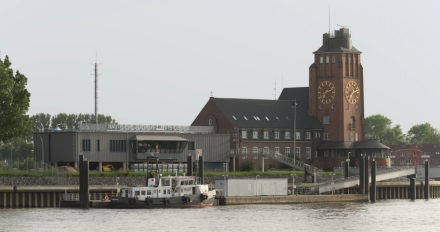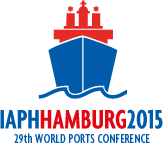
The Vessel Traffic Service Centre (VTS Centre - Nautische Zentrale): One of the World’s most modern Vessel Surveillance Centres
Efficient logistics and energy efficiency are the two pillars the smartPORT Hamburg concept is based on. The refurbishment and upgrading of the VTS Centre is another milestone in the HPA’s efforts towards establishing an intelligent port management system. Pioneering energy technology and technical innovations make the VTS Centre of the Port of Hamburg one of the most modern vessel surveillance centres in the world. Since the beginning of the 20th century, the VTS Centre has been responsible for monitoring and regulating vessel traffic within the port area, ensuring the safety and efficiency of vessel movements in the Port of Hamburg on a 24/7 basis 365 days a year. In order to adequately deal with the challenges higher traffic volumes and larger container vessels present and to ensure a sustainable and competitive development of the Port of Hamburg, the HPA started to comprehensively refurbish and upgrade the VTS Centre in line with the latest technical, space-planning and energy-saving standards in January 2012. The VTS Centre plays a key role in the Port of Hamburg’s traffic management: the complete overhaul and refurbishment makes it well placed for the future.
State-of-the-art technical tools and technology support the VTS Centre in monitoring and regulating vessel traffic on the River Elbe and within the port area in a safe and efficient manner. One of these tools is the Port Monitor, a control station system specifically developed for the VTS Centre. Based on nautical charts the system displays in real time all vessel movements within the port area - be it on large screens or mobile end devices. In addition, the Port Monitor provides a high level of trans-parency as it pools all vessel-relevant data and supplies information on current construction sites, obstructions and closures, current water levels and bridge clearance heights. On top, the VTS Centre is equipped with the latest monitoring technology such as radar gadgets, AIS (Automatic Identification System) and video technology, IT-supported data sharing networks, VHF radio communication as well as six state-of-the-art nautical workstations.
The mixture of traditional and modern architecture posed a number of refurbishment challenges: the energy transition calls for a sustainable use of resources, but at the same time it is almost impossible to heat-insulate the heritage-listed pilots’ station located on the Seemannshöft right next to the VTS Centre and make it more energy-efficient. However, the HPA has managed to find the perfect resource-saving concept to cope with the challenge by installing a thermal ice storage system with heat pump. The underground ice storage system consists of long water pipes that absorb the excess heat generated by the VTS Centre’s technological equipment throughout the year. The heat pump uses the stored waste heat to heat the building during the cold season: if heat is withdrawn from the ice storage system, the liquid in the water pipes will freeze releasing crystallisation energy that is used to cool the technical equipment in the VTS Centre. By recovering the waste heat, the HPA reduces CO2 emissions as well as energy costs as only the heat pump requires electricity.
Under a joint project with the University of Hamburg and the Hamburg Informatik Technologie Center [Technology Centre for Computer Science], the HPA examined the work processes and technical systems of the VTS Centre. The results of the fifteen-month-long project formed the basis for the spatial and technical design of the new VTS Centre.
State-of-the-art technical tools and technology support the VTS Centre in monitoring and regulating vessel traffic on the River Elbe and within the port area in a safe and efficient manner. One of these tools is the Port Monitor, a control station system specifically developed for the VTS Centre. Based on nautical charts the system displays in real time all vessel movements within the port area - be it on large screens or mobile end devices. In addition, the Port Monitor provides a high level of trans-parency as it pools all vessel-relevant data and supplies information on current construction sites, obstructions and closures, current water levels and bridge clearance heights. On top, the VTS Centre is equipped with the latest monitoring technology such as radar gadgets, AIS (Automatic Identification System) and video technology, IT-supported data sharing networks, VHF radio communication as well as six state-of-the-art nautical workstations.
The mixture of traditional and modern architecture posed a number of refurbishment challenges: the energy transition calls for a sustainable use of resources, but at the same time it is almost impossible to heat-insulate the heritage-listed pilots’ station located on the Seemannshöft right next to the VTS Centre and make it more energy-efficient. However, the HPA has managed to find the perfect resource-saving concept to cope with the challenge by installing a thermal ice storage system with heat pump. The underground ice storage system consists of long water pipes that absorb the excess heat generated by the VTS Centre’s technological equipment throughout the year. The heat pump uses the stored waste heat to heat the building during the cold season: if heat is withdrawn from the ice storage system, the liquid in the water pipes will freeze releasing crystallisation energy that is used to cool the technical equipment in the VTS Centre. By recovering the waste heat, the HPA reduces CO2 emissions as well as energy costs as only the heat pump requires electricity.
Under a joint project with the University of Hamburg and the Hamburg Informatik Technologie Center [Technology Centre for Computer Science], the HPA examined the work processes and technical systems of the VTS Centre. The results of the fifteen-month-long project formed the basis for the spatial and technical design of the new VTS Centre.
smartNEWS



